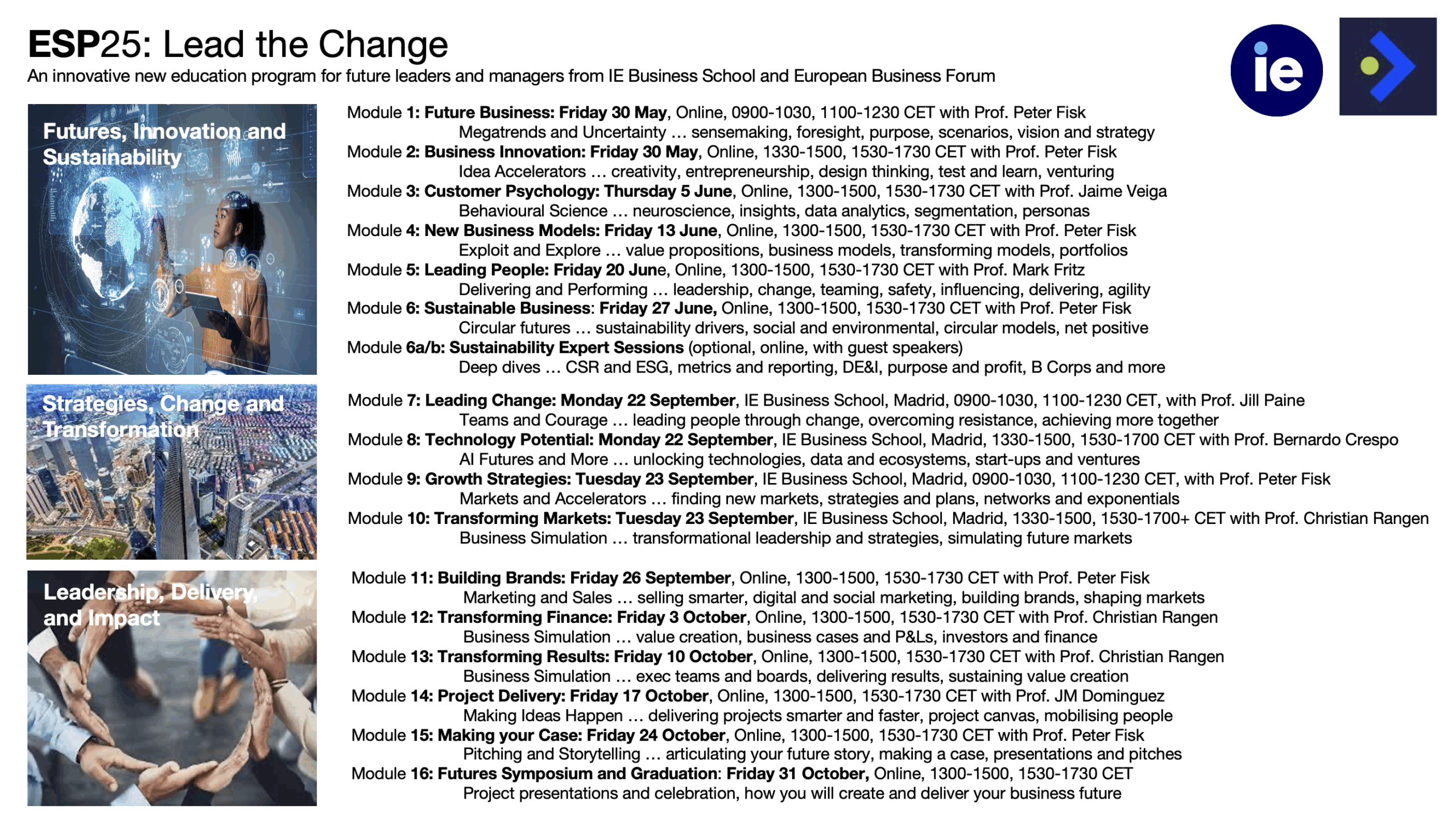Leading the Change: Making your Case
October 24, 2025 at ESP25

Incredible technologies and geopolitical shifts, complex markets and stagnating growth, demanding customers and disruptive entrepreneurs, environmental crisis and social distrust, unexpected shocks and uncertain futures.
For every business leader, the challenge is about making sense of today’s rapidly changing world, and understanding how to prepare for, and succeed, in tomorrow’s world.
We explore how businesses can survive and thrive, and move forwards to create a better future. How to reimagine business, to reinvent markets, to reengage people. We consider what it means to combine profit with more purpose, intelligent technologies with creative people, radical innovation with sustainable impact.
We learn from the innovative strategies of incredible companies – Alibaba and ASML, Biontech and BlackRock, Canva and Collossal, NotCo and Netflix, Patagonia and PingAn, Spotify and Supercell, and many more. We also take a look at what this means for insurance, and some of the most innovative companies in the field.

Are you ready to seize the opportunities of a changing world?
How will you – and your strategy, organisation, people and projects – embrace the challenges and opportunities of change ahead of us? Where are your biggest opportunities for innovation and growth? What are your priorities to balance short and longer term? How will you behave as a manager and leader?
We’ve developed a new program for business leaders, managers of companies large and small, to get up to speed with the very latest ideas, tools and approaches to business, learning from companies and experts around the world. It’s called the Executive Management Program, delivered as a hybrid program online and in face to face in Madrid.
It’s like a Mini MBA, but fit for today’s world, where challenges like economic uncertainty and climate change are matched by opportunities like the applications of AI and new business models. It includes an exciting dynamic business simulation, about managing and leading change, plus insights and ideas from the world’s most interesting companies, right now.
In fact it brings together much of the Global Online MBA from IE Business School, which is ranked #1 in the world, and in particularly for topics such as ESG and sustainability. The faculty is made up of expert professors from IE and beyond, and we spend a number of days in Madrid at IE’s Executive Education campus.
For more info, contact me directly: peterfisk@peterfisk.com

Module 15: Making your Case, Business storytelling and strategic persuasion
In a world of relentless change, bold ideas and visionary strategies are not enough. To make transformation happen, leaders must make their case—powerfully, clearly, and persuasively. Whether you’re a founder pitching investors, a CEO aligning your board, a transformation leader rallying teams, or a product lead convincing stakeholders to back a new direction, your ability to structure and communicate your message will determine whether your vision moves forward or stalls.
In business today, where attention is scarce and skepticism is high, how you frame your argument is as important as the substance of your idea. To make your case effectively is to lead.
Why clarity and structure matter more
Most major change initiatives fail not because the strategy was wrong, but because the vision wasn’t understood, the need for change wasn’t clear, or the plan didn’t feel credible. A strong message:
-
Creates urgency and builds the case for why change is necessary.
-
Inspires belief in a better future and builds emotional engagement.
-
Instills confidence in the plan by showing that it is thought through, practical, and actionable.
In a world of competing priorities, making your case is how you win time, resources, and commitment. It’s how you move ideas off whiteboards and into real change.
Start with the end in mind
One of the most powerful frameworks for structuring ideas is Barbara Minto’s Pyramid Principle, which begins with the end in mind. Rather than building up to a conclusion, you start with your main message and support it with a logical structure of arguments and evidence. This helps your audience quickly grasp your point and follow your reasoning.
At the heart of the Pyramid Principle are three levels:
-
Top-level message (the answer, or big idea)
-
Key supporting points (reasons why it’s true or important)
-
Supporting evidence (facts, data, examples, or logic)
This format is especially useful in executive settings, where time is short and clarity is prized. For example:
We must pivot from product-centric sales to customer-centric solutions
– because it drives growth through higher lifetime value
– because customer expectations have fundamentally changed
– and because our competitors are already doing it
Each of these reasons is backed by specific data and examples.
By stating your key point upfront, you command attention, establish relevance, and make it easy for others to engage.
Frame the message around change
In making a case for business transformation, you must build a narrative that covers three essential elements:
-
Why we need to change
-
Where we’re going
-
How we’ll get there
This structure mirrors the classic storytelling arc: problem, vision, and resolution.
1. Why We Need to Change
This is your burning platform. What’s broken, unsustainable, or at risk? Use data, trends, and external realities to show why staying the same is not an option. Create urgency, not fear.
Examples:
-
“Customer acquisition costs have doubled over the past 18 months.”
-
“Regulatory changes are making our current model unsustainable.”
-
“Digital-native competitors are capturing our future growth segments.”
This part of your case must feel real and non-optional.
2. Where We’re Going
Paint a compelling picture of the future. What could the business become? What new value will we create? This is where emotion, vision, and ambition come in. Help people imagine the opportunity and believe it’s possible.
Examples:
-
“We will become the most trusted wellness platform in our category.”
-
“We will reinvent insurance as a proactive partner, not just a claims payer.”
-
“We will create a marketplace that makes every small business globally scalable.”
This is your North Star—the ‘why’ that inspires belief and commitment.
3. How We’ll Get There
Now connect the dots. What are the key strategic moves? What’s the roadmap, the operating model shift, the cultural change? People want to see that you’ve thought things through.
This part of your message should cover:
-
Key initiatives or programs
-
Enablers (e.g., technology, partnerships, capabilities)
-
Phases or timeline
-
Risks and how you’ll manage them
-
What success looks like
Borrow from startup pitch decks
Startup founders are trained to pitch big, bold ideas in tight, structured formats. Many of these formats translate well to any change or transformation initiative. The classic pitch deck structure often includes:
-
Problem – What’s the pain or challenge?
-
Solution – How are you solving it?
-
Market – What is the opportunity?
-
Product / Approach – What are you building or changing?
-
Business Model – How will it create value?
-
Go-to-Market – How will it reach and impact the market?
-
Traction – What progress or validation exists?
-
Team – Who is delivering the change?
-
Ask – What do you need (investment, support, resources)?
If you’re making a case inside a large organization, modify this to suit internal transformation:
-
Strategic context instead of market size
-
Operating model changes instead of a product demo
-
Impact metrics instead of revenue forecasts
-
Capability or culture shifts as part of your execution plan
Telling a credible, compelling story
Great business storytelling blends logic and emotion. It helps people believe in the future and see themselves in it. Here’s how to do that effectively:
-
Use contrast: Show the gap between where we are and where we could be.
-
Bring data to life: Use simple visuals, analogies, and comparisons.
-
Make it human: Include voices from customers, employees, or partners.
-
Speak in outcomes: Focus on results, not just activities.
-
Rehearse and refine: Clarity comes from iteration, not inspiration.
Avoid common traps like being too abstract, too tactical, or too internally focused. The best cases for change are anchored in external reality, inspired by purpose, and grounded in practical steps.
Getting others on board
Making your case is not a one-time event. It’s an ongoing conversation. You may need to tailor your message for different audiences: the board, the frontline, finance, marketing, operations. Each has different concerns and motivations.
-
For executives: Focus on strategic fit, financial impact, and risk.
-
For teams: Emphasize purpose, clarity, and what it means for them.
-
For skeptics: Bring evidence, examples, and answer objections respectfully.
Repetition matters. So does consistency. A well-structured core message—aligned across presentations, meetings, documents, and communications—builds momentum.
This is leadership
Making your case is not just about communication. It’s a form of leadership. It’s how you turn bold ideas into collective action. It’s how you connect people to purpose. It’s how you win support, build alignment, and drive change.
In today’s world, the ability to envision the future and articulate it with clarity and conviction is what separates those who dream from those who deliver.
Because ultimately, transformation doesn’t begin with a strategy. It begins with a story—one worth believing in.
Find out more and book >